| Domaine de l'Amauve |
| Our vintages. | Index |
| The vineyard | The winemaking |
.
| . |
. |
| Our line of action. |
At Domaine de l'Amauve, we
consider that the vineyard is the heart of our work. The quality of our
wines is primarily due to the vine and the attention we will have paid
to it throughout the year. The winemaking is an important moment because it reveals the potential of the grapes. However, it is very simple and traditional at the estate, and do not use any new technique. However, the precision that is brought to our winemaking comes from the great experience acquired over the years. The estate is certified Organic. The winemaking meets the Organic specifications. The wines we likes to make have a nice density, are perfectly balanced, are aromatics and precises. An input such as sulfur is used at its lowest dose. No fining is practiced on red wines, and some cuvees are unfiltered. |
| . |
. |
| The winemaking of our white wine. |
The white wine from Domaine de l'Amauve is obtained from four traditional white grape varieties from the South Rhône Valley. The grapes are harvested by hand. They are carefully pressed using a pneumatic press. The juices are then racked in small temperature-controlled tanks for several hours to allow their impurities to settle. They are then racked again and directed to the fermentation tanks. The yeasts that will ensure the fermentation will developp fairly quickly. The temperature is precisely controlled during the fermentation. The fermentation will last from 4 to 5 weeks. After this fermentation phase, the white wines will be racked again to separate their rough lees and will be kept in tanks on their fine lees until the bottling. |
| . |
. |
| The winemaking of our rosés wines. |
The working method for obtaining roses wines is very close to that of white wines. The main difference comes from the grapes varieties, which are traditional red grapes varieties from the South Rhône Valley, and the maceration (short maceration) in the press before pressing, that allows a small part of the skin color of the grapes to pass into the juice. |
| . |
. |
| The white and rose wines tanks. |
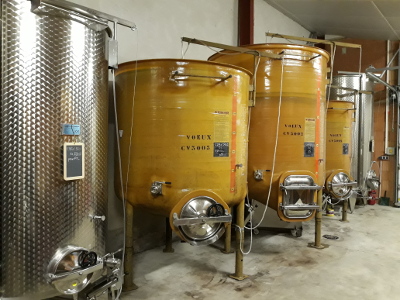 |
| . |
. |
| The winemaking of our red wines. |
Our red wine cuvees are made from traditional red grapes varieties from the South Rhône Valley. Five grapes varieties are use with our red wines. They are harvested manualy. When they enter the cellar, the grapes are destemmed, and then bring into the fermentation tanks. Destemming is important because it allows us to work during the maceration of the grapes only on the extraction of the beautiful tannins from the skin of the berry. The yeasts that are doing the fermentation are naturally present in the vineyard and on the berries. They will develop slowly in the fermenting tank and have a great diversity, which contributes to the aromatic complexity of our cuvees. . We are using fermentation tanks made with concrete, stainless steel or fiberglass depending on the size of the tank and the cuvee. At the end of the maceration, the free run wine is racked off, and the pomace (skin of the berries) is pressed to give the press wine. The free run wine and the press wine may be blend later depending on their tasting. Some of our cuvees will be aged in barrels for 12 months. Red wines are bottled without any fining and after a rough filtration or even without any filtration if their natural clarification is sufficient. |
| . |
. |
| The red grapes into the fermenting tank. |
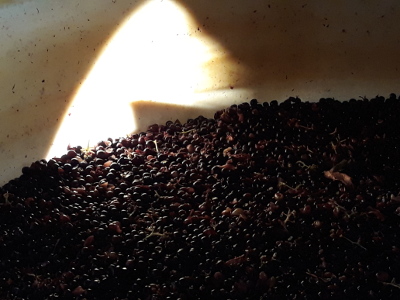 |
| . |
. |
| The fermentation of the red grapes. |
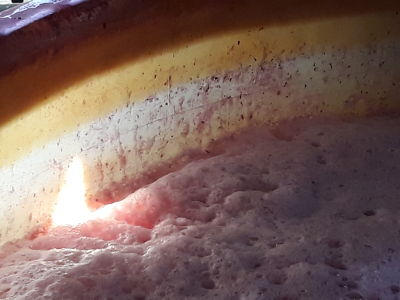 |
| . |
. |
| The ageing in barrels of some of our cuvees. |
Some of our red wine cuvees are aged for 12 months in barrels. The barrel are from a Burgundian cooper. They are 228 liters Burgundy pièces. They are bought new and used for five to seven years. |
| . |
. |
| The ageing of our red wines in barrels. |
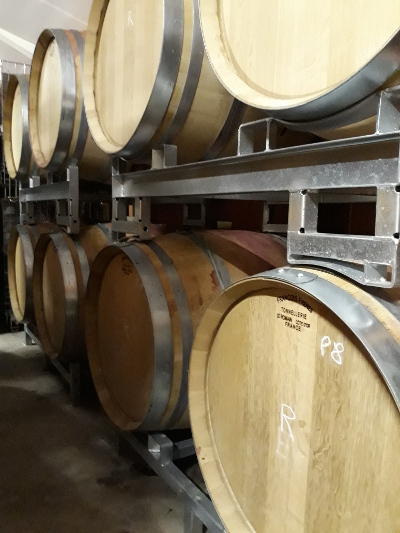 |
| . |
. |
| The bottling and the storage of the bottles. |
The wines from Domaine de
l'Amauve are bottles with high-tech equipments to protect the wine
under inert gas during this delicate phase. That allows us to use a minimum dose of sulfur during this operation. After bottling, the different cuvees are kept into our air-conditionned storage rooms in order to preserve all their qualities. |
| . |
. |
| Temperature controlled bottle storage. |
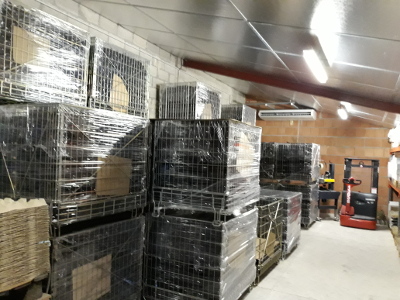 |
| . |
. |
.
[ Top of the page ]